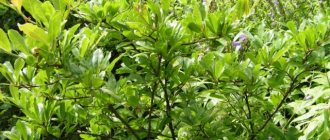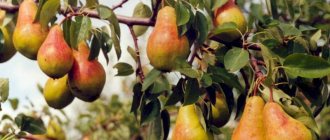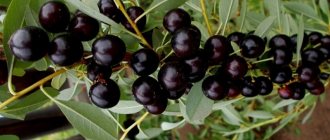The tree with large glossy leaves, similar to the crown of an indoor ficus, and exotic saucer-shaped flowers with a divine aroma is considered subtropical.
However, many species are grown quite successfully in temperate latitudes. The real spring holiday begins in the parks of Western Germany, Transcarpathia, Polesie, when the magnolia blossoms.
Planting and care in the open ground are accompanied by measures aimed at protecting the plant from winter cold; otherwise, a deciduous or evergreen tree or shrub requires no more care than other decorative inhabitants of the garden.
According to botanists, the Magnoliaceae family is one of the oldest on Earth. Its first representatives lived 140 million years ago during the era of dinosaurs.
They are considered a transitional link between gymnosperms, or conifers and angiosperms - flowering plants.
The shape of the magnolia fruit in the form of a cone and the abundance of essential oils in all parts of the tree confirm its relationship with conifers.
Together with its relatives in the family Schisandra chinensis, tulip liriodendron and Michelia, the magnolia tree is, in fact, the progenitor of all modern flower flora.
Previously, luxurious plants lived in areas much north of the current temperate latitudes, but after the ice ages they disappeared forever from those places.
They are now found growing wild only in Southeast and East Asia, certain regions of the Far East and the North American continent.
The genus Magnolia received its name in honor of P. Magnol, a French botanist, and at first it was pronounced like that - Magnolia.
Over time, the name acquired a modern meaning. The genus includes approximately 240 species, similar and at the same time different, but always incredibly beautiful plants.
Planting and caring for magnolia
- Flowering: early spring, some species - early summer.
- Planting: mid to late October or April.
- Lighting: bright sunlight, partial shade possible for several hours.
- Soil: light, moderately moist, rich in organic matter, slightly acidic or neutral.
- Watering: regular, even constant: the soil under the magnolia should be slightly moist all the time. Regular watering is especially important for seedlings under three years of age.
- Fertilizers: fertilizers applied during planting are enough for two years. From the third season, complex mineral-organic fertilizers must be applied from early spring to mid-summer. For example: a solution of 15 g of urea, 1 kg of mullein and 20 g of ammonium nitrate in 10 liters of water - such fertilizer in an amount of 40 liters is applied instead of watering once a month.
- Pruning: there is no need to form the magnolia crown, and sanitary pruning is carried out after flowering.
- Reproduction: usually by cuttings, layering, grafting. For breeding experiments, you can use the seed method.
- Pests: roseate thrips, mealybugs, peach aphids, spider or transparent mites, rodents.
- Diseases: chlorosis, seedling rot, powdery mildew, gray mold, sooty fungus, botrytis and scab.
Read more about growing magnolia below.
Choosing the time and place of landing
Disembarkation time
If you bought your magnolia in a container or pot, it can be replanted from mid-March to the end of September. The method of planting a plant from a pot (container) is most preferable, because it is planted with a small amount of soil to which it is accustomed. In this case, the plant adaptation occurs much faster.
Landing place
Before planting the plant, you need to study the microclimate of the garden or area where you are going to plant the magnolia. Lighting plays a huge role in successfully growing magnolias. As you know, these plants are quite heat-loving, but young plants cannot stand the scorching sun at midday: the result of “overheating” may be leaves of a light yellow color.
Planting a magnolia tree in the Moscow region
If you plant a magnolia in a less sunny place, the level of green pigment increases. That is why the plant should be planted in the shade of another tree. In the image above, a magnolia tree was planted in the floor shade of pine trees, a good solution, the pine trees will not only provide shade to the floor, but also slightly acidify the soil with their fallen pine needles.
As for air pollution, the varieties Kobus (lat. Kobus) and magnolia Soulangiana (lat. Soulangiana) cope well with a large percentage of emissions from enterprises and car exhaust gases.
General landing rules
Magnolia should be planted in light and slightly moist soil.
The soil composition should include turf soil, peat and compost in a ratio of 2:1:1, respectively.
In order not to spoil the root system, you should dig a hole three times the size of the roots. You should not compact the soil from above, so as not to harm the roots.
The soil under the seedling must be covered with coniferous bark - this technique will help maintain the water balance in the soil.
To prevent the roots from drying out when planting, be sure to buy seedlings in special containers.
Botanical description
The magnolia plant may be a deciduous tree or shrub with brown or ash-gray bark that is smooth, furrowed, or scaly. Magnolia can reach a height of 5 to 20 m. Large scars from leaves and narrow ring-shaped scars from stipules are noticeable on its shoots. Magnolia's buds are large, as are the entire-edged, leathery, emerald green leaves with pinnate venation and slight pubescence below, which for the most part have an obovate or elliptical shape. Single fragrant bisexual terminal or axillary flowers with a diameter of about 6 to 35 cm, white, cream, pink, red, lilac or purple, consist of 6-12 imbricated elongated waxy petals, arranged in one or more rows. Magnolia blooms in early spring, but some species bloom in early summer. Any person who has seen a magnolia blossom will definitely want to grow this tree in their garden.
The magnolia fruit is a collective cone-shaped leaflet, consisting of many one- or two-seeded leaflets. Magnolia seeds, triangular, black, with a fleshy pink or red aneurysm, hang on the seed threads when the leaflets open.
The magnolia tree, like the magnolia shrub, is a highly ornamental plant. It is especially beautiful in spring: a blooming magnolia is a sight that will be remembered forever. But magnolia is valued not only for its beauty: its flowers, fruits, leaves and even the bark contain essential oils, which are a unique antiseptic for rheumatism, hypertension and diseases of the gastrointestinal tract.
- Sowing flowers in April in open ground
Description of magnolia with photo
Depending on where they grow, magnolias can be evergreen or deciduous. Some species are multi-stemmed shrubs, while others are spreading trees, quite massive.
Sometimes, under the influence of climate or environment, plants can change their growth form and partially adapt to environmental conditions. In garden culture, both low-growing (up to 2.5 m) species, which look great in group planting, and large trees are grown.
Blooming magnolia tree
Magnolias have gained great popularity as ornamental plants due to their magnificent blooms. Large and fragrant flowers are painted in all shades of pink; there are varieties with white, cream and even yellow colors. A blooming magnolia can be seen from afar, and in the early spring garden a rare plant can compare with its beauty. Most deciduous species bloom from April to May, while evergreen species usually bloom in May and early summer. Sometimes you can expect re-blooming at the end of August.
How to grow garden Brugmansia, winter care and reproduction
Unfortunately, the flowering period for many representatives of the genus is short, on average two to three weeks. To enjoy the flower show for as long as possible, you can create compositions in the garden from early, mid and late flowering varieties.
Numerous simple ovaries in the center after flowering form a cone-shaped fruit in which red, round arils ripen. Each of them contains one black seed, which, after the epithelium opens, often hangs down on thin seed filaments.
Planting magnolia in the garden
When to plant
Magnolia does not grow everywhere, but if your area is suitable for growing it, then plant it in a sunny area, protected from north and east winds, away from large trees, so that the shadow does not fall on it: slight shading is permissible only in the southern regions. Magnolia also has requirements for the composition of the soil: it should not be heavily limed or saline, too wet, heavy or sandy. Neutral and slightly acidic soils rich in organic matter are considered optimal. When purchasing planting material, give preference to a seedling about 1 m high with one or two buds and a closed root system so that it does not dry out while waiting for planting. Seedlings whose root system is in a container can be planted in open ground in spring, summer, and autumn.
As for the timing of planting, most experts consider the best time for this to be autumn from mid to late October, when magnolia seedlings are already dormant. When planted in autumn, almost 100% of seedlings take root. Magnolia is planted in spring in April, but you need to keep in mind that even minor return frosts can greatly harm the trees that have begun to grow.
How to plant
When preparing a planting hole, you need to take into account that its size must be at least twice the volume of the seedling’s root system. The top fertile layer soil removed from the pit should be mixed with rotted compost, and if the soil is too dense, add a little sand to it.
Place a layer of drainage material - crushed stone, broken brick or crushed ceramic tiles - 15-20 cm thick in the hole, then place a layer of sand about 15 cm thick on top, and a layer of prepared fertile mixture on top of it. Place a magnolia seedling in the center of the hole so that the root collar after planting is 3-5 cm above the surface. Fill the remaining space of the hole with soil mixture, lightly compact the surface and water the plant generously. When the water is absorbed, mulch the trunk circle of the magnolia seedling with peat, and on top of it with dry bark of coniferous trees to protect the soil from too rapid evaporation of moisture.
Magnolia varieties for the Moscow region
Many varieties are quite hardy, so they can be grown in the Moscow region without much difficulty following our recommendations.
The most resistant varieties are Kobus (lat. Kobus), Loebner (lat. Loebneri kache).
Relatively resistant varieties are Wilson (lat. Wilson), Siebold (lat. Sieboldii) and Ash (lat. Ashei).
Even in severe frost, only some buds of these varieties freeze, which does not harm the entire tree as a whole. The longer the magnolia is in central Russia, the higher its winter hardiness; a couple of years after planting the magnolia, shelter for the winter is no longer required.
Magnolia buds
There is no need to worry if in the first years after planting the plant blooms for only 7-12 days, while the flowers are very rare - this is the norm for a plant that is still adapting to the climatic zone of the Moscow region. A couple more years will pass, and your magnolia will delight the eye with its blooms for 30 days!
Caring for magnolia in the garden
Growing conditions
Magnolia needs moisture constantly. Seedlings aged from one to three years especially need regular and abundant watering. The soil in the tree trunk circle should be moist, but not wet, and the water for irrigation should be warm. You only need to loosen the soil in the tree trunk circle with a pitchfork and very carefully, since magnolia has a shallow root system that is easily damaged by garden tools. Therefore, it is recommended to mulch the tree trunks of magnolias.
Growing magnolia involves adding fertilizer to its tree trunk. Trees up to two years old need enough nutrition from the soil during planting, but from the age of three they need to start feeding. Magnolia is fertilized in the first half of the growing season. As a top dressing, you can use ready-made mineral complexes, the packaging of which indicates the required dosage, but you can make up a top dressing yourself: dissolve 20 g of ammonium nitrate, 15 g of urea and 1 kg of mullein in 10 liters of water. To feed one mature tree you will need 40 liters of this solution. Apply it instead of watering once a month. Please note that it is easy to overfeed a magnolia, and if you find that its leaves have begun to dry out prematurely, stop fertilizing and increase the water flow when watering.
Transfer
Magnolia does not tolerate transplantation very well, but if you have such a need, do everything as it likes: find the most suitable place, taking into account the growth dynamics of magnolia. Before you dig up a plant, be sure to water it well and remember that the larger the earthen lump on the roots of the plant, the easier it will take root. The magnolia is dragged to a new location on a piece of oilcloth or a sheet of plywood. The transplant is carried out in the same order as the initial planting: first, prepare a spacious hole, put drainage, sand, and some fertile soil in it, and then install a magnolia in the center of the hole and fill the free space with earth, leaving the root neck of the plant above the surface of the area. There is no need to compact the soil around the plant too much, just press it lightly with your hands.
After transplantation, abundant watering is carried out, and then the tree trunk circle is mulched. If the transplant was carried out in the autumn, a mound of dry soil should be poured into the tree trunk circle for the winter - this measure will protect the root system of the plant from freezing. The trunk and branches of the transplanted tree are wrapped in cloth for the winter.
Trimming
Magnolia does not need formative pruning in the garden, and sanitary cleaning is carried out only after flowering: shoots frozen in winter, wilted flowers, dry branches that thicken the crown are removed. Fresh cuts need to be treated with garden varnish. Do not prune magnolia in the spring, since all plants of this genus are characterized by intense sap flow and can die from wounds.
Pests and diseases
For a long time it was believed that magnolia was invulnerable to diseases and pests and suffered from completely different problems. For example, sometimes yellow spots begin to appear on its leaves - chlorosis. At the same time, the veins of the leaves remain green. This is a signal that there is a lot of lime in the soil, and the magnolia root system in such an environment develops poorly and dies. In this case, you need to add acidic peat or coniferous soil to the soil. You can also use commercially available chemicals, such as iron chelate, to restore the required acidity level.
Oversaturation of the soil with fertilizers slows down the growth and development of magnolia, since soil salinization occurs from excess nutrients. You can determine that too much fertilizer has accumulated in the roots by the drying out edges of the old leaves of the plant at the end of July. Stop fertilizing and increase water flow when watering.
Among insects, magnolia can be harmed by roseate thrips, mealybugs and peach aphids, and during dry periods spider mites or transparent mites can settle on the plant. All these pests suck the juices out of the magnolia, weakening the plant. As a result, the leaves from the tree begin to fall off in July or August. Sucking pests sometimes weaken the magnolia so much that the next year it produces almost no growth. In addition, they carry incurable viral diseases. Mites, thrips, mealybugs and aphids need to be combated with acaricides - treating the tree with a solution of Actellik, Aktara or a similar drug.
In winter, magnolia may suffer from rodents that eat the roots and root collar of the tree, but you will only know about this if you remove the top layer of soil. If you find gnaws, treat them with a one percent solution of Fundazol and henceforth cover the trunk circle for the winter only after the top layer of soil freezes. In this case, rodents will not reach the roots.
- Caring for roses in winter
Among the diseases in our climate, magnolia can be affected by fungal infections: seedling rot, powdery mildew, gray mold, sooty fungus, botrytis and scab. These diseases can be dealt with if they are detected in time and measures are taken immediately: reduce watering and treat the plant with a fungicide solution. It is possible that processing will have to be carried out more than once. And against bacterial spotting, magnolia is treated with copper sulfate.
Sowing stratified magnolia seeds in the ground
Around mid-January, prepare a container or box (depending on the number of seeds). Don't forget that it should have holes to drain excess water. Fill this container with a good loose and fertile mixture. Additions of vermicompost (for nutritional value) and vermiculite (for moisture retention) are welcome.
Sow stratified magnolia seeds into this mixture to a depth of 3 cm and place the crops on a light and warm windowsill. Although light is not necessary yet. In fact, the seeds will need another two months to appear “into the light of day.” And don’t forget to water the seemingly empty container all this time.
By March 8, the first magnolia shoots should appear; this is where plants need light, so they need a south-facing window sill and artificial lighting.
At this stage, differences in growth rates between species are clearly visible. My fastest growing magnolias were Soulanges, Lebner and obovate, large-flowered. Although this may be due to differences in soil mixture and location (this issue has been poorly studied).
And then - regular watering and, if desired, fertilizing with fertilizers for seedlings. Magnolias are quite tenacious and, with good care, grow well even in the first year. In different species, their height during the first season ranges from 10 cm to 30 cm.
Of course, the described process can be simplified by immediately sowing the seeds, without cleaning and washing them into the soil mixture, and storing them in the refrigerator or basement, but, as practice shows, germination will be lower. If you need 1-2 magnolia seedlings, do so, but if you are aiming for a large number, then it is better to use the proven technology described above.
What to do at the end of the growing season with grown magnolia annuals? In southern regions with rare and not severe frosts, they can be safely planted in the ground, only sometimes when the temperature drops below 0, giving them an easy shelter. In the northern regions, where frosts are constant in winter, planting should be delayed until spring, or better yet another year, so that the seedlings become stronger. Seedlings of deciduous magnolias should overwinter at a temperature of +0...+5 degrees, or without light (in the basement).
This year's magnolia seedlings. © Igor Bilevich
Magnolia propagation
Reproduction methods
Magnolia is propagated by seed and vegetative methods - cuttings, layering and grafting, but only the vegetative method allows one to obtain hereditarily identical plants. To be fair, it should be said that generative propagation helps to develop new varieties, varieties or forms, and this method is also the easiest to implement.
Growing from seeds
Magnolia seeds ripen in September. Place the collected fruits on paper, shake out the seeds from them and fill them with water for 2-3 days, then rub through a sieve to remove the seeds. To remove oily coating from seeds, wash them in soapy water and then rinse thoroughly in running water. Pack the dried seeds in a plastic bag with wet sand or sphagnum (1:4) and store in the refrigerator on the middle shelf for at least 20 days before sowing - the seeds must undergo stratification.
Before sowing, remove the seeds from the refrigerator, disinfect them in a fungicide solution and place them in damp moss for a while to allow them to sprout. More than half of the stratified seeds germinate, but if the seeds are not prepared, there will be much fewer sprouts.
Magnolia seeds are sown in furrows 2 cm deep and covered with a 1 cm thick layer of soil. Since magnolia has a taproot system, the container for seedlings must be at least 30 cm deep. Seedlings are transplanted into open ground by transshipment when the threat of return frosts has passed. For the winter, they are completely covered with dry peat.
Propagation by cuttings
Cuttings for propagating magnolia need to be taken from young plants, before the buds bloom on the tree. An ideal cutting should be green on top and woody at the bottom. The cuttings are planted at the end of June or beginning of July in a greenhouse, where the temperature and humidity of the air and soil can be controlled. Sand or a mixture of sand with peat, perlite and vermiculite is used as a substrate. Rooting should take place at a temperature of 20-24 ºC, and then the appearance of roots on the cuttings can be expected within five to seven weeks. Large-flowered magnolia cuttings take twice as long to root. Try to strictly observe the temperature regime, since at lower temperatures the process will proceed much more slowly, and at temperatures above 26 ºC the cuttings will die. During the entire cutting period, the greenhouse must be ventilated and the soil must be kept moist.
Reproduction by layering
Shrub magnolias are propagated by layering: in the spring, a low-growing branch of the plant is tied at the base with soft copper wire, bent, secured, and a small mound of earth is poured at the attachment point. The process of root formation will go faster if you make a circular cut at the point where the branch comes into contact with the soil.
Magnolia can also be propagated by air layering. At the end of spring or early summer, make a circular cut of the bark 2-3 cm wide on the branch of your choice. Try to do this carefully so as not to damage the magnolia wood. Treat the cut with Heteroauxin, cover the wound with damp moss and wrap it in cling film, securing it above and below the cut. Then tie the branch to neighboring branches so that it does not get damaged in strong winds. Keep the moss moist: spray it several times a month, piercing the film with a syringe of water. After two or three months, roots will form at the cut site. In the fall, cuttings are cut from the branch and grown at home.
Preparing for winter
Most adult magnolias grown in the middle zone are quite resistant to low temperatures, although early flowering species and varieties are susceptible to freezing of flower buds. The least frost-resistant and most demanding is the grandiflora magnolia, which should only be planted in warmer regions.
What fertilizers and when to feed garden plants?
However, even adult plants grown in climates with harsh winters need to be protected from frosty winds. In the autumn, before severe frosts, the tree trunk area and the base of the trunk are covered with soil or peat to a height of at least 20 cm. The soil can be replaced with straw, spruce branches or pine bark (5-10 cm layer).
The trunk is wrapped with a straw mat or burlap in several layers, and the crown with dense, white agrotextile. Such insulation will help avoid the appearance of frost holes in windy and snowless winters.
Magnolia propagation by cuttings
These beautiful trees can be propagated by cuttings, but the success rate is slightly above 50%. Magnolia grown from seeds will bloom only after 5-10 years, seedlings from cuttings will bloom in about 2-3 years.
The material is collected before the budding period. Take apical cuttings 15-20 cm long; green ones on top and semi-lignified ones at the bottom take root best.
Magnolia cuttings
Only 2-3 leaves are left on the cuttings, which are cut to half to reduce moisture evaporation.
Leaves are cut to half
Use a knife to lightly scrape 5 cm of bark at the end of the cutting and make a vertical cut 2.5 cm long.
The cut is dipped in a hormone that stimulates the formation of roots, after which the cuttings are planted in a mixture prepared from 1 part fertile soil and 3 parts perlite or coarse sand.
Planting cuttings in the ground
Water well and cover the pot with a transparent bag to create greenhouse conditions. Place the cuttings in a well-lit place, but without direct rays.
Every day the bag is opened for 5 minutes for ventilation and the cuttings are sprayed with warm water every 3-4 days. During rooting, old leaves may fall off. After about 4-6 weeks, new growth will appear, which is a sign of successful rooting. The pot is kept closed for another 2-3 weeks.
TOP – 19 unpretentious long-flowering perennials
Acclimatization of a young plant:
- open the package for 4-5 hours in the next 3-4 days;
- remove the bag and place the pot in the shade for 1 week;
- subsequent exposure to morning or evening sun for 1 week;
- after this period, begin to take the pot out into the fresh air for one hour, increasing the time by an hour every day.
The next step will be to transplant the seedlings using the method of transshipment into open ground to a permanent place.
Growing magnolia from seeds
Magnolia is easy to grow from seeds taken from ripe fruits in September-October, but the resulting seedlings may not reproduce the varietal characteristics of the parent plant.
Magnolia seeds
The collected seeds are placed in warm water for 2-3 days to soften the seed shell. The sticky skin is difficult to remove, so the seeds are carefully rubbed between your fingers or washed in water with the addition of dishwashing detergent, after which the soap is rinsed off with running water.
To germinate, seed material must undergo cold stratification, which imitates natural conditions. Therefore, the seeds are placed in a bag in damp vermiculite or peat and closed. The package is stored in the refrigerator at a temperature of 2-3 ° C for 3 months.
After the expiration of the period, the seeds are removed and if there are no signs of germination, the shell is lightly scarified with sandpaper to facilitate germination.
Then they are disinfected with a fungicide solution and sown to a depth of 2 cm in pots with an earthen mixture prepared from compost, peat and sand (perlite) in a ratio of 2:1:1. Shoots appear unevenly, after about 5-6 weeks.
Magnolia seedlings
By autumn, seedlings usually grow up to 25 cm.
During the first winter they are left in a cool and bright room, reducing watering. Planted in open ground after the last possible frost using the transshipment method.
Magnolia after flowering
Preparing for winter
Magnolia blooms in spring or early summer, and it is a sight to behold: a magnolia in bloom is the queen among garden trees. And when this holiday is over, you will have to do sanitary pruning of the tree: remove wilted flowers, broken ones, dead in winter from frost, and branches and shoots growing inside the crown. But even without flowers, magnolia is decorative due to its beautiful leathery leaves.
Magnolia in winter
When deep autumn arrives and the garden begins to fall asleep, your task is to prepare a shelter for the magnolia, because even the most winter-hardy species of this genus can suffer from frost, especially in a windy and snowless winter. To avoid frost damage, wrap the tree trunk in two layers of burlap, being careful not to damage the fragile branches. Then, after waiting for real frosts, cover the tree trunk circle with thick mulch. Now your beauty will not be afraid of frost, mice or other rodents.
Diseases and pests of magnolia
The main problem when growing magnolia in a temperate climate is freezing of the pagons.
The shrub or tree is resistant to most diseases of ornamental garden plants.
Chlorosis of leaves is sometimes observed due to insufficient or untimely application of nutrients.
In this case, it is necessary to feed the plants with a complete mineral complex with microelements.
In dry weather, spider mite colonies are found on crops. It’s a good idea to organize sprinkling irrigation; if the situation is too neglected, the plants are treated with appropriate chemicals.
In winter, bushes or trees suffer from mice and hares that eat the bark under the snow and above its surface.
Blooming magnolia is a spectacular decoration of parks, streets and estates.
In the best proximity to the plant in the garden, they grow red maple, western thuja, crenate holly, highbush blueberry, common hemlock, downy sumac and staghorn sumac.
But even in the solitaire version in the center of the lawn, a magnolia in bloom will not leave any eye indifferent.
Types and varieties
The largest collections of magnolias are collected in the UK: in the Arnold Arboretum introduction center and in the Royal Botanic Garden. But there is an excellent collection in Kyiv, and it is the Ukrainian experience of growing magnolias that gives hope for the promotion of this plant to the east and north. The most common types of magnolia in cultivation are:
Magnolia sieboldii
This is a deciduous tree up to 10 m high, but more often a tall shrub with broadly elliptical leaves up to 15 cm long and fragrant cupped, somewhat drooping white flowers on a pubescent thin peduncle. The diameter of the flowers is from 7 to 10 cm. This is one of the most winter-hardy species, tolerating short-term frosts down to -36 ºC. The species has been in cultivation since 1865;
Magnolia obovate (Magnolia obovata)
Or white-flowered magnolia comes from Japan and the island of Kunashir, in the Kuril Islands. This is a deciduous tree with gray, smooth bark, reaching a height of 15 m. The leaves of this magnolia are collected in 8-10 pieces at the ends of the shoots, and beautiful flowers up to 16 cm in diameter, creamy-white in color, have a spicy aroma. The fruits are bright red and reach a length of 20 cm. This tree is decorative at any time of the year; it tolerates shading and frost well, but is demanding in terms of soil and air moisture levels. The species has been in cultivation since 1865;
Magnolia officinalis (Magnolia officinalis)
The plant comes from China, an analogue of magnolia obovate, but with larger leaves. Its flowers are also large, fragrant, reminiscent of water lilies, but with narrower petals, pointed towards the top. In China, this species is used as a medicinal plant, but in our area, magnolia officinalis is still rare;
- Tips for growing salvia in the garden
Magnolia acuminata
Or magnolia borage from the central part of North America, where it grows in deciduous forests at the foot of the mountains and along the rocky banks of mountain rivers. It is a deciduous tree up to 30 m high with a pyramidal crown when young, which becomes rounded over time. The leaves are oval or elliptical, up to 24 cm long, dark green above and grayish-green, short pubescent below. The flowers, up to 8 cm in diameter, are bell-shaped and yellow-green, sometimes with a bluish bloom, in color. This is the most cold-resistant representative of the genus. Magnolia borage has a form in which the leaves are either rounded or heart-shaped at the base, and the flowers are smaller than the main species and canary-colored. In the USA, hybrids have also been obtained between Magnolia acuminata and Magnolia Liliaceae, united under the name Brooklyn magnolia;
Magnolia stellata
One of the most elegant and spectacular magnolias comes from Japan. This is a small tree or shrub up to 2.5 m high with bare gray-brown branches, narrow elliptical leaves up to 12 cm long and original flowers up to 10 cm in diameter with numerous snow-white, elongated ribbon-shaped petals directed in all directions, like the rays of a star . This species has two decorative forms: pink and kei. Some varieties and hybrids of this plant are also popular among gardeners:
- Magnolia Susan is a variety with flowers of a dark purplish-red hue on the outside and lighter on the inside. This variety is part of a series of hybrids with female names - Judy, Betty, Anna, Pinky, Randy, Jane and Ricky - which were bred in the 50s of the last century.
Magnolia liliflora
Particularly widespread in culture. It supposedly comes from eastern China, and the plant came to Europe in 1790. Magnolia Liliaceae blooms profusely with lily-shaped flowers up to 11 cm in diameter. The flowers are purple on the outside, white on the inside, and have a barely noticeable aroma. Of greatest interest is the decorative form of this species, Magnolia Nigre (Nigre), with ruby-red outside and white-lilac inside flowers, opening in late April or early May;
Magnolia kobus
Native to northern and central Japan and South Korea, the species was transported to New York in 1862, from where it spread to Europe in 1879. In cultivation, the plant reaches a height of 10 m, but in nature it can grow two and a half times higher. The leaves of the tree are wide, obovate, with a sharp apex, bright green on top and lighter on the underside. This magnolia is white, fragrant, with flowers up to 10 cm in diameter. The plant blooms in the ninth to twelfth year. The species is frost-resistant, gas- and dust-resistant. The northern form of the species is a plant with larger flowers and is even more resistant to low temperatures;
Magnolia grandiflora
Originates from the southeastern states of North America. It has a slender cylindrical trunk, a beautifully shaped crown, dark green, large shiny leaves and white flowers up to 25 cm in diameter, with a strong spicy aroma. Even the fruits of this plant are attractive: they have an original cone-like shape, are brightly colored and very impressive. At a young age, Magnolia grandiflora develops slowly, growing annually by only 60 cm. It is not frost-resistant either, withstanding cold temperatures of at least -15 ºC, but it copes well with urban conditions, is resistant to diseases and pests and is durable. The main decorative forms of Magnolia grandiflora are:
- narrow-leaved - a plant with leaves narrower than those of the main species;
- lanceolate - a plant with elongated leaves;
- the famous magnolia with very wide leaves and flowers up to 35 cm in diameter;
- round-leaved - this plant has very dark green leaves and flowers up to 15 cm in diameter;
- early - magnolia, blooming earlier than the main species;
- exonskaya - a tall tree with a narrow pyramidal crown shape and oblong leaves pubescent below;
- Praverti - magnolia with a strictly pyramidal crown;
- Gartvisa is a tree with a pyramidal crown and wavy leaves;
- dragon - a plant with a low-hanging crown, the branches of which, hanging in an arched manner, touch the ground and take root easily;
- Gallison - magnolia with higher winter hardiness than the main species.
Magnolia Sulangeana (Magnolia x soulangeana)
This is a hybrid bred in 1820 by the French scientist Etienne Soulange. Since then, more than 50 forms of this hybrid have been registered and are incredibly popular throughout the world. Magnolia Sulange is a deciduous shrub or tree up to 5 m high with obovate leaves up to 15 cm long and goblet flowers with a diameter of 15 to 25 cm, sometimes fragrant, and sometimes completely odorless, with petals ranging from soft pink to purple, and only occasionally there are specimens with white flowers. The plant is resistant to unfavorable climatic factors and grows well in soils of different compositions. Of the numerous garden forms of this hybrid species, the most commonly grown are:
- Lenne - magnolia with fragrant white flowers inside and pink-purple outside;
- Alexandrina is a drought-resistant plant up to 8 m high with flowers that are dark purple on the outside and white on the inside;
- Red (rubra) - with pink-red flowers on the outside;
- Nemetsa is a magnolia with a pyramidal crown shape.
In addition to the described garden forms, there are various varieties of magnolia Solange.
In addition to the described plant species, in cultivation you can also find willow magnolia, large-leaved magnolia, Lebner magnolia, naked magnolia, three-petal magnolia, or umbrella magnolia, and others.
How does magnolia reproduce?
In general, the magnolia tree reproduces in 2 main ways:
- vegetative propagation, for which cuttings of an adult shrub or layering are taken;
- seed propagation - magnolia is grown directly from seeds.
In practice, vegetative methods are used more often, since propagation is easier and allows you to quickly grow a beautiful ornamental shrub. But propagation from seeds also has its advantages; this method allows you to maintain the purity of the variety and obtain a plant with increased endurance.
Types of magnolia
The flowering tree has several types:
- Kobus. A small tree reaching a height of up to 5 meters. It grows for about 30 years. Before the first leaves appear, the tree is already covered with cup-shaped flowers. Does not tolerate severe frosts very well, some buds die.
- Star-shaped. Habitat: moist mountain forests. It reaches a height of up to 3 meters. The flowers resemble small stars in appearance. The plant tolerates frost well and has been actively blooming since April.
- Lebner. Hybrid of star magnolia and kobus. It reaches a height of up to 5 meters and grows for about 25-28 years. In severe frosts, the buds partially freeze. It begins to bloom in April, before the leaves appear.
- Naked. The Chinese are very fond of this type. It can reach a height of up to 15 meters. The flowers are cup-shaped, white or cream in color. It tolerates frosty weather without loss.
- Lily-flowered. Prefers a humid climate. It can grow as either a small tree or a bush. It begins to bloom in May and until July. The flowers are slightly narrowed. Tolerates frosts with freezing of shoots. This type of magnolia is recommended to be planted in areas with moderate humidity and the absence of cold winds.
- Sulanzha. Hybrid of bare magnolia and lily flower. It grows mainly in the form of a tree. Under good conditions it can reach up to 8 meters. Flowering begins in April. In severe frosts it suffers losses.
- Obovate. Can reach a height of up to 30 meters. Has large leaves. It tolerates frosts without loss. Prefers a humid climate. It is recommended to plant in the shade.
- Kyuvenskaya. Is a hybrid. Grows in the form of a tree. The color palette is white, the flowers look like small bells with a delicate aroma. It begins to bloom in April. The whole tree has an aniseed odor. It grows quite quickly and tolerates frost without loss.
What magnolias can be grown in the middle zone
Of the large number of varieties of magnolia, two of them are suitable for growing in the middle zone - star magnolia (Magnolia stellata) and kobus . Both plants are deciduous shrubs (less commonly, trees) with large fragrant flowers of white or pink color. Depending on the variety, they can be simple or terry.
- Magnolia star
The shortest plant of the Magnolia genus, on which numerous stars “light up” in early spring.
- Magnolia Kobus
A cold-resistant magnolia whose spring blooms are simply mesmerizing.
In addition, a hybrid of star magnolia and kobus magnolia, Loebner magnolia (Magnolia × loebneri), has taken root well in the middle zone. In severe winters, only some of the buds of this plant freeze, but this does not prevent the tree from recovering. Moreover, with age, magnolia gets even more accustomed to the cold, and an adult plant is already able to winter without shelter.
In the gardens of the middle zone, star magnolia varieties most often grown are Royal Star (with huge white flowers), Rosea (with simple pink flowers) and Waterlily (with white double flowers).
How to prepare magnolia for winter
Young magnolia bushes must be covered with spunbond for the winter . This is necessary not only to help the plants survive the winter, but also to protect them from birds: birds love to feast on magnolia buds.
Wrapping the trunk with two layers of burlap will save the plant from frost damage. But this is done very carefully, since magnolia has fragile branches.
Mulching also helps to warm the roots for the winter . It should be done regularly, but especially in late autumn. Dry fallen leaves, peat, humus, tree bark, pine branches, and straw are suitable as mulch.
In young plants, when the soil freezes a little, the tree trunk circle is also protected with non-woven material. Rodents will not be able to set up their home in such a shelter.
As you can see, if you follow all the rules of agricultural technology and proper care, you can grow magnolia in the middle zone. Don't be afraid to experiment - and you will succeed!
Selecting an area for planting
When choosing a site for magnolia, you need to take into account that it requires light. Preference should be given to areas away from trees with tall trunks. In addition, it is important to protect the magnolia from northeast winds. In light shading conditions, it is allowed to grow it only in warm regions.
Excessively saline and limed soil is not suitable for growing the crop. In addition, sandy, heavy or wet soil varieties should be avoided. The most suitable are neutral and slightly acidic substrates saturated with organic matter.
Related article:
Barberry Thunberg Admiration
Reproduction by cuttings
Gardeners prefer propagation by cuttings primarily because flowering occurs earlier. Hybrid varieties of magnolia are grown using cuttings. If you propagate a tree by seeds, it will lose its maternal qualities.
Almost all types of plants begin to bloom in April. Cuttings for propagation must be cut before the tree begins to set buds. For the landing to be successful, you must make the right choice of terrain. In places where the wind is constantly blowing, there is a draft, the tree will not survive. Magnolia needs a place well protected from such phenomena. For example, a tree can be planted near a high fence, or near the wall of a house.
The soil for magnolia should be neutral, but you can also slightly acidify it. Soil containing lime will destroy the root system of the plant. Young cuttings have no chance of development in such conditions. Growing in such soil will not be successful. Soil containing sand is also not suitable for magnolia.
The optimal soil for a tree is fertile and light. In the weighted version, magnolia will not take root.
It is best to choose a young plant that is only a few years old for cuttings. It is healthy and full of strength, which means it can pass it on to a new generation, and at the same time it will not suffer.
Ideal cuttings look like this:
- The top is green.
- The lower part is stiff.
Such a cutting will cope with all the difficulties associated with planting in open ground. It is recommended to cut the green cuttings in the evening or in the morning.
The ideal time for planting cuttings is the last days of June, the first days of July. During this period, climatic conditions contribute to good development. There should be a few leaves left on the top of the cutting. If they are very large, you can cut off half.
To prevent water loss from the cuttings, they are either planted immediately or stored wrapped in a pact in the refrigerator.
To make germination faster, small cuts are made from the bottom of the cutting (preferably with a blade) and treated with growth stimulants. To avoid fungal diseases, you can treat with fungicides.
In order for the cutting to successfully take root, develop well and grow, it is better to start growing it in greenhouse conditions. In this case, you will be able to independently control air humidity, soil moisture, and other factors.
Cuttings take root best in a sandy substrate.
In order for the cuttings to germinate quickly enough, a certain temperature regime should be maintained - 20 ° C, and in no case less. Under such conditions, germination will occur in almost 2 months (about 7 weeks). Throughout this period, magnolia needs attention and care. Violations of the temperature regime will lead to death, regardless of whether the temperature drops or rises.
It is very important to monitor soil moisture. Watering should be moderate. Drying out will not benefit the cuttings, and excessive moisture will lead to rotting of the root system. Also, due to the large amount of water, cuttings may slow down in growth.
The general period of growing magnolia from cuttings lasts about 4 months. After this time, your garden will be decorated with a magnificent flowering tree.
Magnolia species that have large flowers take longer to take root.
How Siebold's magnolia blooms
As soon as the leaves bloom in mid-May, the shrub immediately blooms. This period is short: by June the Siebold magnolia will fade. It may produce several buds in August.
Newly bloomed flowers are cup-shaped; after a few days they will begin to resemble a saucer. The diameter of the flower does not exceed 10 cm, the number of petals ranges from 6 to 9 pieces. They are wide, pointed towards the edge, concave. The length of one petal can be 6 cm, width - 4 cm. In the center of the flower there are stamens, dark pink and red. There are a lot of buds on a magnolia bush; it is literally strewn with them. The aroma of flowers is intense, bright and fresh.










